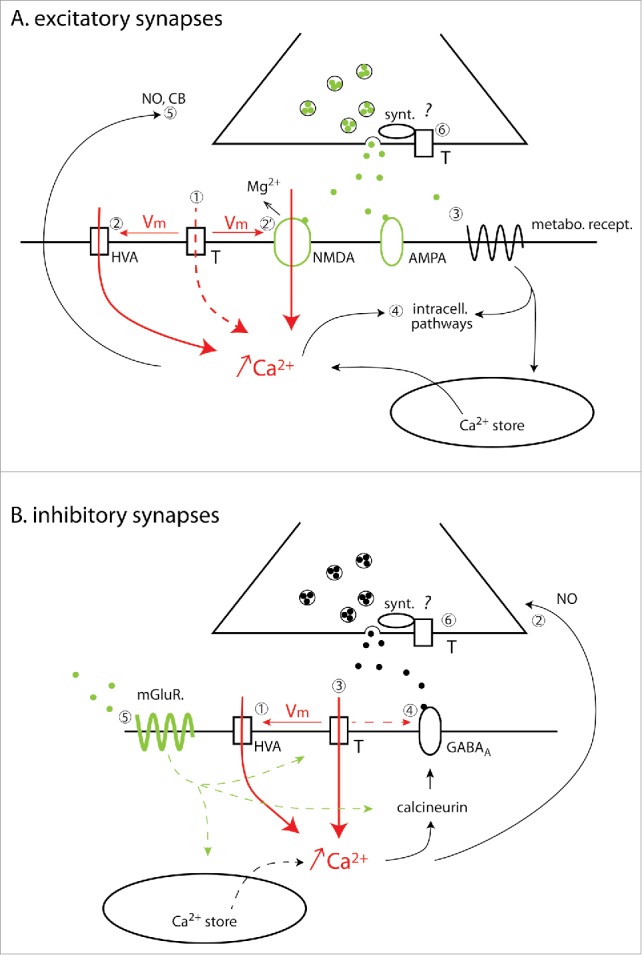Figure 5.

T-type calcium channel-dependent LTP/LTD mechanisms at excitatory and inhibitory synapses. A. Excitatory synapses. Activation of postsynaptic T-type calcium channels induces a post-synaptic Ca2+ increase either directly (1) and/or as a consequence of the membrane potential (Vm) depolarization that can in turn either trigger the opening of the HVA Ca2+ channel (2) and/or relieve the Mg2+ block of NMDA receptors (2′). In addition to T channels activation, various types of metabotropic receptors can be recruited (3) further enhancing intracellular Ca2+ concentration by mobilizing the Ca2+ stores. The increase in Ca2+ concentration activates multiple intracellular pathways (4) mediating post-synaptic long-term plasticity or producing the retrograde messengers, nitric oxide (NO) or cannabinoid (CB) (5) that modify the presynaptic release probability. Finally, presynaptic T-type channels (6) directly interact with proteins involved in the exocytotic machinery like syntaxin 1A (synt). Further studies will clarify whether these presynaptic T-type channels are also involved in synaptic LTP/LTD. Note that a postsynaptic Ca2+ increase specifically supported by the Ca2+ influx through T-type channels has not yet been demonstrated as a required step for LTP/LTD induction at excitatory synapses. B. Inhibitory synapses. T-type channel activation depolarizes the postsynaptic membrane potential (Vm), opening L-type HVA Ca2+ channels (1). The resulting increase in intracellular Ca2+ concentration triggers NO production that diffuses retrogradely to the presynaptic element (2) and induces pre-synaptic LTP through guanylate cyclase activation. A different mechanism, independent of HVA channel activation, requires Ca2+ ions specifically entering in the post-synaptic dendrite through the T-type channels to activate the phosphatase calcineurin and trigger LTD (3). In this case, only activated GABA receptors are down-regulated suggesting a state-dependent interaction with either calcineurin or the T-type channels (4). In addition, LTD also requires the concomitant activation of metabotropic glutamate receptors (5) that may potentiate the T-mediated Ca2+ influx, recruit intracellular Ca2+ stores and/or modulate intracellular pathways. Note that T-type channels are also potentially present on inhibitory pre-synaptiC-terminals (6) where they directly interact with proteins involved in the exocytotic machinery like the syntaxin 1A (synt). In both A and B, dashed lines are used when no definite experimental evidence are available to support the proposed mechanism.
